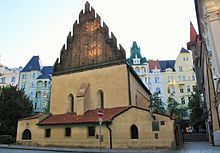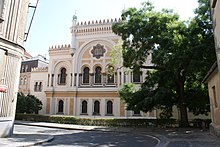Judaism in Prague

The story of the Jews in Prague describes the life and rich culture in one of the most important Jewish communities in Europe. Personalities such as Rabbi Löw , Franz Kafka , Franz Werfel and others worked in Prague . a. The Jewish Museum in Prague has one of the world's largest collections of Jewish artifacts and is now a tourist attraction.
history
Beginnings
In the 10th century there were traveling Jewish long-distance traders in Prague such as Ibrahim ibn Jakub . The first mention of Jewish settlements under Prague Castle and in the village of Vyšehrad is in 1091 . In 1098 some of the Jews fled to Poland and Hungary.
From 1174/78 the first privilege for Jews was obtained from Soběslav II . In the 13th century, the formation of a self-contained Jewish town , today's Josefov district, took place. The Gothic old-new synagogue dates from this period and is still preserved today. Around 1260 the rights of the Jews were extended by Otokar II Přemysl . In 1389 there was a serious pogrom in which up to 3,000 people are said to have been killed.
Golden age

From 1502 the opportunities for Jews in Prague improved. A rich cultural life developed in the city. In 1521 the first Hebrew printing house north of the Alps was set up by Gerson Katz . During the reign of Emperor Rudolf II , the Jewish community experienced an economic boom, embodied by the community leader Mordechai Meisel . Prague became the center of Jewish learning in Europe. Many Jewish scholars lived and published in Prague. Among them was Jehuda Löw , the legendary creator of the golem .
18th century
Around 1709 there were more Jews in Prague than in any other European city. In 1744 Maria Theresa ordered the expulsion of the Jews from the city. From 1748 Jews were allowed to live in Prague again for a limited period.
The Toleration of Joseph II. In 1782 expanded the freedoms for Jews in Bohemia. For example, Jewish doctors were now also allowed to treat non-Jewish patients.
emancipation
In the 19th century the city became a center of the Jewish Enlightenment ( Haskala ).
In 1848 there was extensive equality and the Jews were given full civil rights. In 1849 the ghetto in Prague was dissolved and Jews were allowed to settle in the entire city. Prague developed into an important center of Jewish culture and literature. Many Jews were now studying at the university. Jewish student bodies such as Bar Kochba emerged .
In 1896 the sports club DFC Prague was founded by Jewish students .
20th and 21st centuries
The Zionist movement spread in Prague. In 1907 the magazine Selbstwehr was founded.
In 1918 Prague became the capital of the new Czechoslovak Republic . The conditions were good for the Jewish population. In 1922, after Samuel Steinherz was appointed rector of the university, anti-Jewish protests broke out. In the 1930s, Prague became an important host for Jewish refugees from Germany.
After the invasion of the Wehrmacht and the establishment of the German Protectorate of Bohemia and Moravia in 1939, the persecution of the Jews of Prague and their emigration began. Jewish institutions were closed and property confiscated. The systematic deportation of Prague Jews began in 1941, initially to the Litzmannstadt ghetto and later to the Theresienstadt concentration camp . Of the almost 49,500 Jews who lived in Prague at the start of the war in 1939, only about 7,500 survived the Shoah .
Many surviving Jews emigrated to Israel or the United States after the Second World War. The Slansky trial was directed against 14 leading Czechoslovak party members, including 11 Jews, who were convicted and executed.
Few Jews still live in Prague today. The Jewish community of Prague has around 1500 members. The Jewish Museum in Prague looks after the numerous sights and presents the city's Jewish history.
In 2008, Prague was the first Czech city in which Gunter Demnig laid stumbling blocks . In 2016, along with Olomouc and Brno, it was one of the cities with the most stumbling blocks in the Czech Republic.
Synagogues
- Old New Synagogue
- High synagogue
- Klausen Synagogue
- Jerusalem Synagogue
- Pinkas Synagogue
- Maisel Synagogue
- Spanish synagogue
graveyards
swell
- David Gans : Zemach David , around 1613, History of Prague's Jewish City
literature
- Samuel Steinherz (Ed.): The Jews in Prague. Pictures from its thousand-year history . Prague 1927 online
- Arno Pařík: Jewish Prague . Jewish Museum, Prague ³2005
- Ctibor Rybár: The Jewish Prague. Glosses on History and Culture - Guide to Memories , TV Spectrum / Akropolis Verlag, Prague 1991, ISBN 80-85334-05-4
- Inát Hermann; Josef Teige; Zikmund Winter; Adolf Kašpar: The Prague Ghetto , Prague 1903. online.
Web links
- Website of the Prague Jewish Community (Czech, English, Hebrew)
- Jewish Museum Prague
- Arno Pařík: Prague. In: YIVO Encyclopedia of Jews in Eastern Europe. October 12, 2010, accessed August 12, 2015 .
- Portal holocaust.cz on holocaust.cz/de / ... (German), in particular the sections / history and / database of victims
Remarks
- ↑ Chronica Boemorum
- ↑ cf. SH Lieben: Hebrew letterpress printing in Prague in the 16th century. In: Samuel Steinherz (Ed.): The Jews in Prague. Pictures from its thousand-year history . Prague 1927, pp. 88-106 online
- ↑ Tobias Weger : A Little History of Prags. Pustet, Regensburg 2011, p. 127f.
- ^ Annual report 2017 Jewish community in Prague


